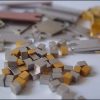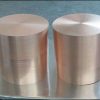
This article briefly introduces the basic properties and common preparation methods of tungsten-copper alloys, and analyzes the related factors that affect the density and uniformity of the alloys to increase powder activity and reduce powder particle size; try not to use additives. It is believed that using fine and uniform mixed powder as raw materials, adopting isostatic pressing or injection molding and appropriate subsequent processing, etc., can improve the uniformity of the structure of the tungsten copper alloy.
Tungsten-copper alloy is a pseudo-alloy (pseudo-alloy) composed of tungsten and copper in which two-phase monomers that are neither miscible nor form intermetallic compounds are uniformly mixed. Because tungsten copper alloy not only has the characteristics of high temperature resistance, high hardness, high density of tungsten, but also has the comprehensive properties of copper, such as high electrical conductivity and thermal conductivity, and good plasticity, and this comprehensive performance can also be improved by different ratios of components Adjustment, so it is widely used as electrical contact materials, electrode materials, high temperature materials, electronic packaging and heat sink materials. However, because the properties of tungsten and copper are quite different, and the two are neither miscible nor form intermetallic compounds, it is difficult to obtain a tungsten-copper alloy with high density and uniform structure through conventional powder metallurgy methods.
In response to this situation, this article describes the preparation process of tungsten-copper alloy and its basic characteristics, and systematically analyzes the main factors that affect the density and structure of the alloy, in order to provide a reference for the preparation of high-performance tungsten-copper alloy.
Basic properties and preparation methods of tungsten copper alloy
1.Physical and mechanical properties of tungsten copper alloy
The physical and mechanical properties of tungsten copper alloy are mainly measured by its density, electrical conductivity, hardness, etc.
2.The main preparation method of tungsten copper alloy
- Liquid phase activation sintering method: It is a method developed by the enlightenment of pure tungsten activation solid sintering theory because the high temperature liquid phase sintering method cannot obtain high tungsten-tungsten copper materials close to the theoretical density. This method adds trace activation elements to the preparation of tungsten copper materials to improve the sintering effect, that is, high-density tungsten copper composite materials can be obtained through liquid phase sintering, so it is also called activation-strengthening liquid phase sintering.
- Infiltration method: It is a method of preparing a porous tungsten matrix skeleton with a certain density and strength, and then filling the pores of the porous skeleton with copper liquid with a lower melting point, so that the material can obtain excellent comprehensive properties. At present, this method is widely used in tungsten copper alloy production.
- Direct sintering of mixed powder: The development of nanotechnology has promoted the progress of the preparation process of tungsten copper alloy, because the finer the raw material powder, the lower the sintering temperature required for the alloy and the easier it is to achieve densification. Using ultra-fine or nano-tungsten-copper mixed powder as raw material, a nearly dense tungsten-copper material can be obtained by direct sintering at a relatively low temperature.
- Other preparation methods: In recent years, some new process technologies have emerged in the preparation of high-performance tungsten copper materials, such as rapid orientation, solidification technology, fiber reinforcement method, arc melting method, in-situ reaction casting method, and specific structure method. Wait.
- In short, as a powder metallurgical composite material with a wide range of applications, tungsten-copper alloy has received widespread attention, but the development of related technologies is still affected by the immiscibility and low density of metal tungsten and copper during the densification process under conventional sintering conditions. Due to the influence of wettability, the degree of densification, distribution of tissue structure, composition and size control, etc. are difficult to reach the ideal state. The indicators that characterize tungsten copper alloys include relative density, uniformity of structure, hardness, tensile strength, thermal conductivity, etc. This article only analyzes its relative density and uniformity of structure.
Relative density and influencing factors of tungsten copper alloy
- 1. The relative density is one of the most important indicators to measure the performance of tungsten copper alloy. Its value is the ratio of the measured density to the theoretical density, which can accurately reflect the density of the alloy with a specific composition. In a sense, the relative density also reflects the number of holes and other defects in the alloy, which directly affects the hardness, uniformity of the structure, and tensile strength of the alloy. The relative density of an ideal alloy should be 100%, but it is impossible to reach this ideal value due to various factors in actual production. It is generally believed that the relative density of an ideal tungsten-copper alloy (ie, high-performance tungsten-copper alloy) should not be lower than 97%.
- 2. The influence of raw material factors: The oxygen content in the powder actually reflects the number of oxides in the powder, and the oxide, as a salt (ie, salt-forming oxide), has a completely different nature from the elemental metal. A simple example is that the elemental metal has basically no wettability to the oxide salt, so it hinders the densification of the tungsten-copper alloy. It can be seen that the oxygen content has an important influence on the performance of the tungsten-copper alloy.
- 3. The influence of the oxides on the surface on the density of the sintered product is manifested in two aspects: one is that during the compression molding process, due to the high elastic modulus of the oxide, the powder is difficult to produce plastic deformation, which makes the formed blank Density decreases; second, in the sintering process, the powder that is not fully reduced can not provide the shrinking force required for sintering shrinkage, and at the same time generates water vapor, both of which have an adverse effect on the densification of the sample.
- 4. High purity and low oxygen content are the prerequisites to ensure that the tungsten powder has good wettability, so as to achieve a good copper infiltration effect. The increase of the oxygen content of tungsten powder increases the infiltration angle between tungsten and the copper solution, and the wettability becomes worse. When the oxygen content is greater than 0.5%, the copper immersion sample will appear serious sandwich phenomenon, and the copper infiltration area is limited. In the surface layer, generally, the oxygen content of tungsten powder cannot exceed 0.2%. Tungsten powder and copper powder with high oxygen content must undergo hydrogen reduction treatment before use. Generally, tungsten powder can be reduced at a temperature of 600 to 900 ℃, while copper powder can be reduced at a temperature of 300 ℃. Because of the low melting point of copper powder, the reduction temperature should not exceed 500 ℃, otherwise it will easily cause copper solidification. Phase sintering.
- 5. With different particle sizes of tungsten powder, the bridging effect and contact surface between the powders are different, resulting in different pressures required for pressing to the same density. Coarse particle tungsten powder is easier to suppress than fine particle tungsten powder. At the same sintering temperature, the porosity of fine powder porous tungsten is smaller than that of coarse powder porous tungsten. Because during the sintering process, the free energy increases as the particle size of the powder decreases, and the larger the free energy, the better the sintering process, that is, the finer powder is easier to densify.






